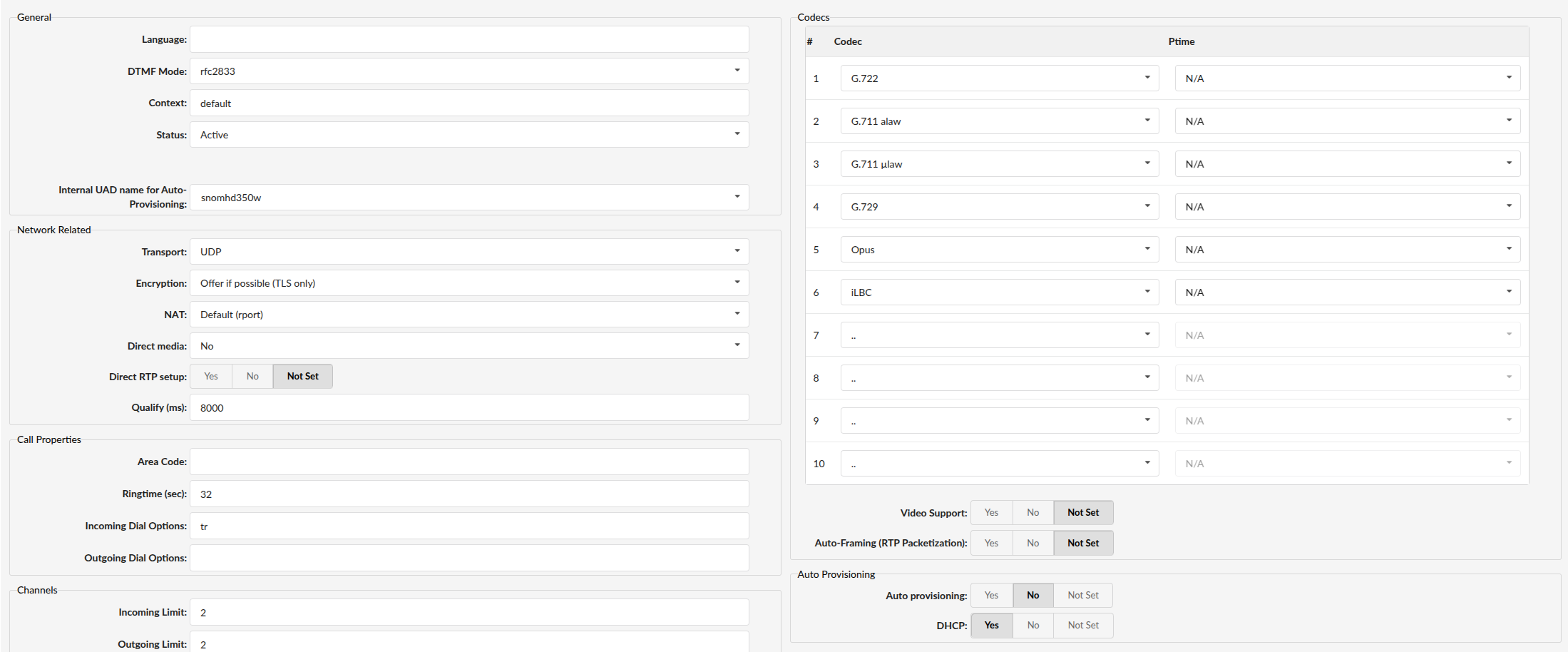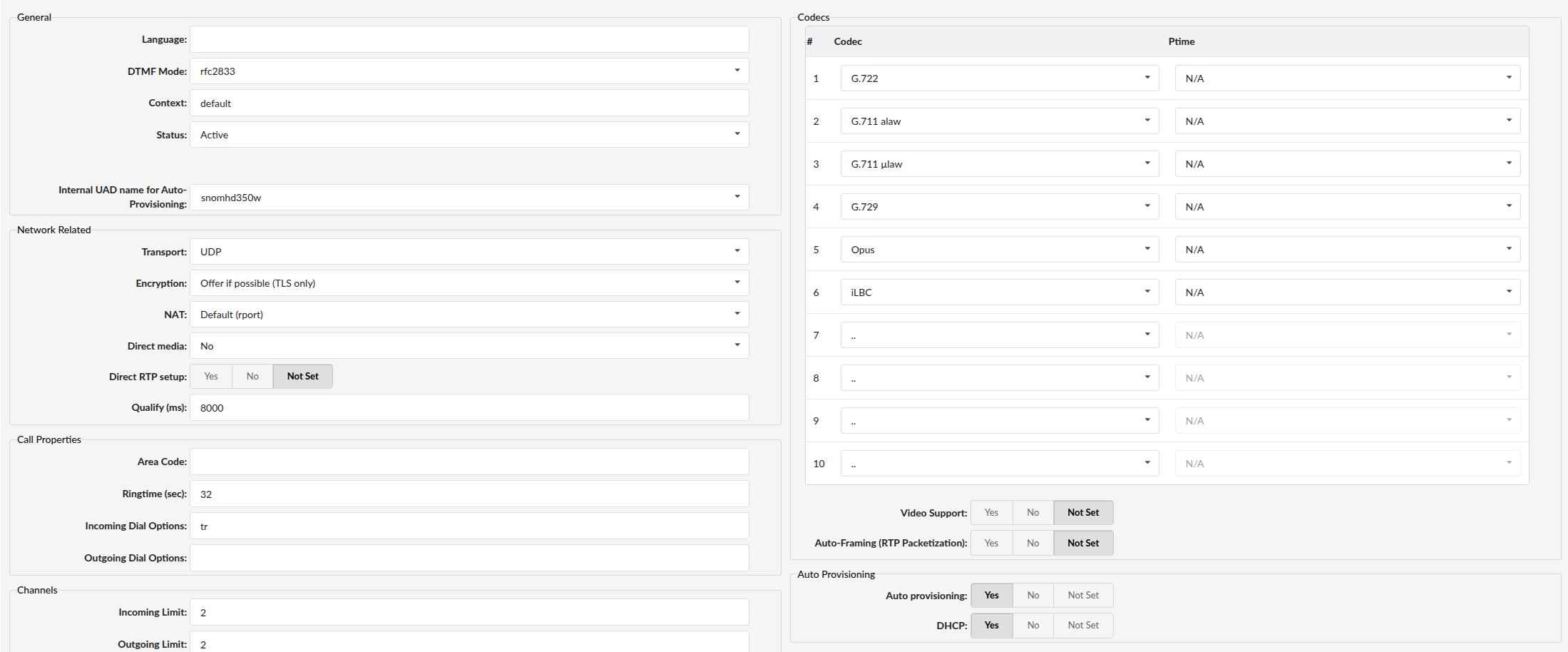¶ Introduction

This Configuration Guide is written as general guide on how to configure the Snom HD351W phone model to work with PBXware v7.6.0.
¶ Requirements
¶ Identifying the Phone Model
To begin and successfully complete the registration of your Snom phone, it is essential to know the exact model you are setting up.
The model information can be found on the back of each Snom phone. While different phone models may share similar requirements and installation procedures, some models can have significantly different requirements and setup processes. Failing to identify your model correctly may result in difficulties or failure to complete the setup.
¶ Phone Firmware
- Make sure that your phone is loaded with appropriate firmware version, 1.0.2.5.
- To find out the firmware version of your Snom phone model, open a new browser window and enter the phone's IP address in order to access the phone's web administration interface login screen. Example:
http://192.168.1.22. - Go to the Status in the top menu.
- The Software Version field displays the current firmware version of device.
¶ DHCP Server
Fully configured and operational DHCP server.
¶ PBXware Version
PBXware version 7.6.0
In order to find out the PBXware version:
- Log in to PBXware
- Navigate to Settings > About
At the top of the About page, you will see a code block similar to this: PBXware Edition: Business, Release: 7 (251dc1c5), Running: 18.15.0-gc-c6df9197, PBXware Proxy v7 (4807ca1), API: 7, libmemcached version: 1.0.18,
The Release field indicates the exact version of your PBXware.
¶ Installation
This chapter describes how to install and connect the phone to the electrical power and data network, as well as how to apply factory settings.
The following topics are covered:
- Power Adapter
- Power over Ethernet (PoE)
- Factory Settings
¶ Power Adapter
Connecting the Network and Power
- Connect the DC plug of the power adapter to the DC port on the phone.
- Plug the other end of the power adapter into an electrical power outlet.
- Connect an Ethernet cable between the Internet port on the phone and the network port on a router or switch to access the LAN.
NOTE: If you are using Power over Ethernet (PoE), you do not need to connect the AC adapter
¶ Power over Ethernet (PoE)
Connecting the Network (PoE)
Using a standard Ethernet cable, your phone can be powered by a Power over Ethernet (PoE) compliant router or switch.
- Connect the Ethernet cable between the Internet port on the phone and an available port on the power router or switch.
NOTE: If you are using Power over Ethernet (PoE), you do not need to connect the AC adapter. Make sure the Ethernet cable and router or switch is Power over Ethernet (PoE) compliant
¶ Find the Phone's IP Address
To locate the IP address of your Snom phone:
- Ensure the phone is idle, then lift the handset.
- Press the following key sequence to access the Voice Menu: TALK [*] [*] [*] [*]
- When the voice prompts begin, press [1] to select Network Configuration.
- Press [2] to hear the phone’s current IP address announced.
¶ Reset to Factory Settings
This step is not necessary for brand new, out-of-the-box phones. However, if the phone has alredy been used, it is required.
- Open a new browser window and enter the phone's IP address in order to access the phone's web administration interface login screen. Example:
http://192.168.1.22. - Click on Servicing.
- Select Provisioning in the left menu.
- Scroll to the bottom of the page and locate the Reset Configuration section.
- Click the Reset button.
- When the confirmation pop-up appears, click OK to proceed.
- Wait for the device to complete the reboot process.
NOTE: Do not unplug or remove power from the device while the factory reset process is in progress.
¶ Registering the Phone
This chapter describes how to identify Snom phone model, requirements that must be met, and how to register the phone using manual configuration or auto provisioning.
The following topics are covered:
- Manual Configuration
- Auto Provisioning
¶ Manual Configuration
This chapter describes how to set UAD settings, create a PBXware extension, and register the phone.
The following topics are covered:
- UAD Settings
- Creating an Extension
- Registering the Phone
¶ UAD Settings
1. Log in to PBXware Web Administration Interface
- Open a new browser window and enter the PBXware IP address to access the web administration login screen. Example:
http://192.168.1.10 - Log in to PBXware using your e-mail address and password.
2. UAD Settings
- Navigate to Settings > UAD.
- Make sure that the Snom HD351W UAD is enabled. To check the UAD status, click on the Edit icon corresponding to the Snom HD351W phone.
- Make sure Status is set to Active, Auto provisioning is set to No, and DHCP is set to Yes.
- Click on the Save button to save changes.

¶ Creating an Extension
1. Add Extension
-
Navigate to the Extensions, then click on Add Extension.
-
The standard options window will be shown below.
-
Select the Snom HD351W phone model from the UAD dropdown menu.
-
Select the Location: Local or Remote.
- Local is for all extensions registered on the LAN
- Remote is for all extensions registered from remote networks (WAN, Internet, etc.)
-
Click on the Next step button.
2. Extension Values
Enter values into the required field text boxes.
REQUIRED FIELDS:
- Name
Enter a name for the extension being created. Example: John Smith
Enter the e-mail address associated with this extension. This e-mail address will receive all system notification messages. Example: john.smith@bicomsystems.com
- Click on the Save button.

¶ Registering the Phone
This chapter describes how to register Snom phone using Hostname or IP Address.
¶ Hostname or IP Address
Log in to the phone's web administration interface
- Open a new browser window and enter the phone's IP address in order to access the phone's web administration interface login screen. Example:
http://192.168.1.22 - Click on System in the top navigation menu.
- In the left menu, under the SIP Account Management section, select Account 1.
- Enter the following details in the respective fields.
REQUIRED FIELDS:
- Enable Account
Make sure the On is selected.
- Account label
PBXware extension name. Example: John
- Display Name
PBXware extension name. Example: John
- User Identifer
PBXware extension number. Example: 103
- Authentication Name
PBXware extension username. Example: 103
- Authentication Password
Enter the Secret of the extension, which was sent to you via e-mail associated with this extension. Example: _%Z4M3*Ts9y7
NOTE: A password is automatically generated for each newly created extension
- Server Address
Enter the Hostname or IP Address of the PBXware.
-
Example for Hostname:
voip.bicomsystems.com -
Example for IP Address:
192.168.1.10 -
At the botton of the page click on the Save button.
-
Wait for the device to complete its reboot.
-
If everything is done as described above, your phone should now be successfully registered with PBXware.
-
To verify the registration, dial *123.
¶ Auto Provisioning
This chapter describes how to set UAD settings, create a PBXware extension, and register the phone using DHCP or Static IP address.
The following topics are covered:
- UAD Settings
- Creating an Extension
- Registering the Phone
¶ UAD Settings
1. Log in to PBXware Web Administration Interface
- Open a new browser window and enter the PBXware IP address to access the web administration login screen. Example:
http://192.168.1.10. - Log in to PBXware using your e-mail address and password.
2. UAD settings
- Navigate to Settings > UAD.
- Make sure that the Snom HD351W UAD is enabled. To check the UAD status, click on the Edit icon corresponding to the Snom HD250W phone.
- Make sure Status is set to Active, Auto provisioning is set to Yes, and DHCP is set to Yes.
- Click on the Save button to save changes.

¶ Creating an Extension
1. Add Extension
-
Navigate to Extensions, then click on Add Extension.
-
The standard options window will be shown below.
-
Select the Snom HD351W phone model from the UAD dropdown menu.
-
Select the Location: Local or Remote.
- Local is for all extensions registered on the LAN
- Remote is for all extensions registered from remote networks (WAN, Internet, etc.)
-
Click on the Next step button.
2. Extension Values
Enter values into the required field text boxes.
REQUIRED FIELDS:
- Name
Enter a name for the extension being created. Example: John Smith.
Enter the e-mail address associated with this extension. This e-mail address will receive all system notification messages. Example: john.smith@bicomsystems.com
- Auto Provisioning
Set to Yes.
- MAC Address
Enter the MAC address of the Snom phone. Example: 001565FF1536
NOTE: You can find the MAC address on the label at the back of the phone
- Click on the Save button.

¶ Registering the Phone
This chapter describes how to register Snom phone using HTTP, HTTPS and TFTP.
¶ HTTP, HTTPS or TFTP
-
Open a new browser window and enter the phone's IP address, e.g.
http://192.168.1.22. -
Click on Servicing in the top navigation menu.
-
In the left menu, select the Provisioning.
-
Decide what server type you intend to use: HTTP, HTTPS or Trivial FTP. NOTE: Our recommendation is to use HTTP.
-
If you decide to use HTTP or HTTPS, enter http:// or https:// followed by Hostname or IP Address, and then followed by /prov/snomhd351w-{mac}.cfg in the Server URL field.
Example of a Hostname using HTTP: http://abc.bicomsystems.com/prov/snomhd351w-{mac}.cfg
Example of an IP Address using HTTP: http://192.168.1.10/prov/snomhd351w-{mac}.cfg
Example of a Hostname using HTTPS: https://abc.bicomsystems.com/prov/snomhd351w-{mac}.cfg
Example of an IP Address using HTTPS: https://192.168.1.10/prov/snomhd351w-{mac}.cfg
-
Enter the Auto Provisioning username and password into the Server Authentication Name and Server Authentication Password fields.
-
If you decide to use the TFTP, enter tftp:// followed by Hostname or IP Address, and then followed by /snomhd351w-{mac}.cfg in the Server URL field.
Example of a Hostname: tftp://voip.bicomsystems.com/snomhd351w-{mac}.cfg
Example of an IP Address: tftp://192.168.1.10/snomhd351w-{mac}.cfg
- Click the Save button at the bottom of the page.
- Go to the Reboot section in the left menu.
- Click the Reboot button to reboot the device.
You will have to wait a couple of seconds for the configuration to be updated. NOTE: Do not power off your phone during this process
The auto-provisioning process will start during the phone's reboot process. The phone will download the appropriate configuration file from PBXware.
If everything is done as described above, your phone should be successfully registered with PBXware.
To verify registration, dial *123.
¶ Additional Configuration Template
If you want to include additional UAD configuration for the Snom HD310W, add fields to the User Agent General Auto Provisioning Template in the Settings -> UAD -> Snom HD351W menu, or add them directly to the Extension in the UAD Auto Provisioning Template section.